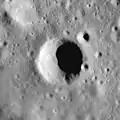Dollond (crater)
Dollond is a small lunar impact crater that is located in the central region of the Moon, to the north of the crater Abulfeda. It was named after British optician John Dollond.[1] Due west of Dollond is Anděl. Dollond is circular and cone shaped, with a tiny floor at the midpoint of the sloping interior walls.
 Apollo 16 image | |
| Coordinates | 10.4°S 14.4°E |
|---|---|
| Diameter | 11 km |
| Depth | 1.6 km |
| Colongitude | 346° at sunrise |
| Eponym | John Dollond |
About 50 kilometers to the northeast of this crater was the landing site of the Apollo 16 mission, the next-to-last of the Apollo expeditions to the Moon.
Satellite craters

By convention these features are identified on lunar maps by placing the letter on the side of the crater midpoint that is closest to Dollond.
| Dollond | Latitude | Longitude | Diameter |
|---|---|---|---|
| B | 7.7° S | 13.8° E | 37 km |
| D | 8.2° S | 12.5° E | 9 km |
| E | 10.2° S | 15.7° E | 6 km |
| L | 8.7° S | 12.5° E | 5 km |
| M | 10.1° S | 16.9° E | 6 km |
| T | 9.4° S | 15.0° E | 3 km |
| U | 7.3° S | 16.0° E | 3 km |
| V | 7.9° S | 15.5° E | 6 km |
| W | 6.7° S | 14.6° E | 11 km |
| Y | 8.4° S | 13.2° E | 14 km |
The following craters have been renamed by the IAU.
- Dolland C — See Lindsay.
Dollond T is the closest named feature to the Apollo 16 landing site, other than the features that were named by the astronauts (such as North Ray and South Ray craters).[2]
 Dollond E
Dollond E Dollond T
Dollond T
References
- Andersson, L. E.; Whitaker, E. A. (1982). NASA Catalogue of Lunar Nomenclature. NASA RP-1097.
- Bussey, B.; Spudis, P. (2004). The Clementine Atlas of the Moon. New York: Cambridge University Press. ISBN 978-0-521-81528-4.
- Cocks, Elijah E.; Cocks, Josiah C. (1995). Who's Who on the Moon: A Biographical Dictionary of Lunar Nomenclature. Tudor Publishers. ISBN 978-0-936389-27-1.
- McDowell, Jonathan (July 15, 2007). "Lunar Nomenclature". Jonathan's Space Report. Retrieved 2007-10-24.
- Menzel, D. H.; Minnaert, M.; Levin, B.; Dollfus, A.; Bell, B. (1971). "Report on Lunar Nomenclature by the Working Group of Commission 17 of the IAU". Space Science Reviews. 12 (2): 136–186. Bibcode:1971SSRv...12..136M. doi:10.1007/BF00171763. S2CID 122125855.
- Moore, Patrick (2001). On the Moon. Sterling Publishing Co. ISBN 978-0-304-35469-6.
- Price, Fred W. (1988). The Moon Observer's Handbook. Cambridge University Press. ISBN 978-0-521-33500-3.
- Rükl, Antonín (1990). Atlas of the Moon. Kalmbach Books. ISBN 978-0-913135-17-4.
- Webb, Rev. T. W. (1962). Celestial Objects for Common Telescopes (6th revised ed.). Dover. ISBN 978-0-486-20917-3.
- Whitaker, Ewen A. (1999). Mapping and Naming the Moon. Cambridge University Press. ISBN 978-0-521-62248-6.
- Wlasuk, Peter T. (2000). Observing the Moon. Springer. ISBN 978-1-85233-193-1.
